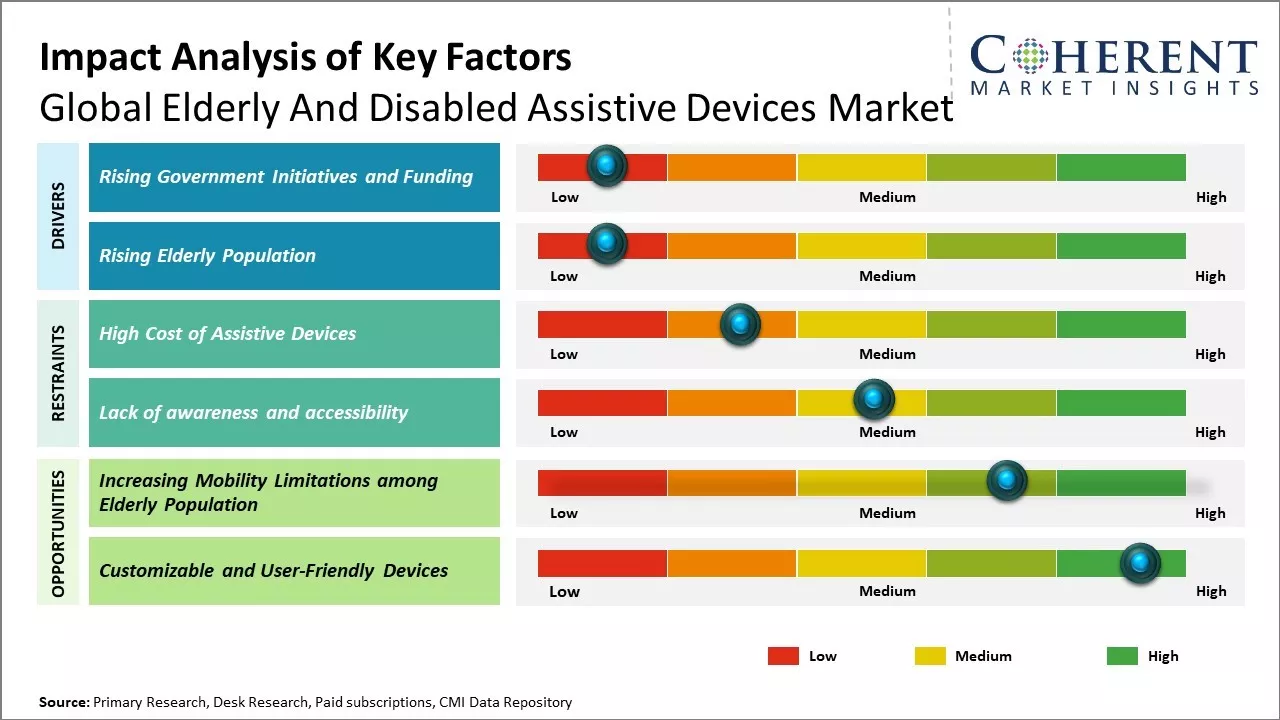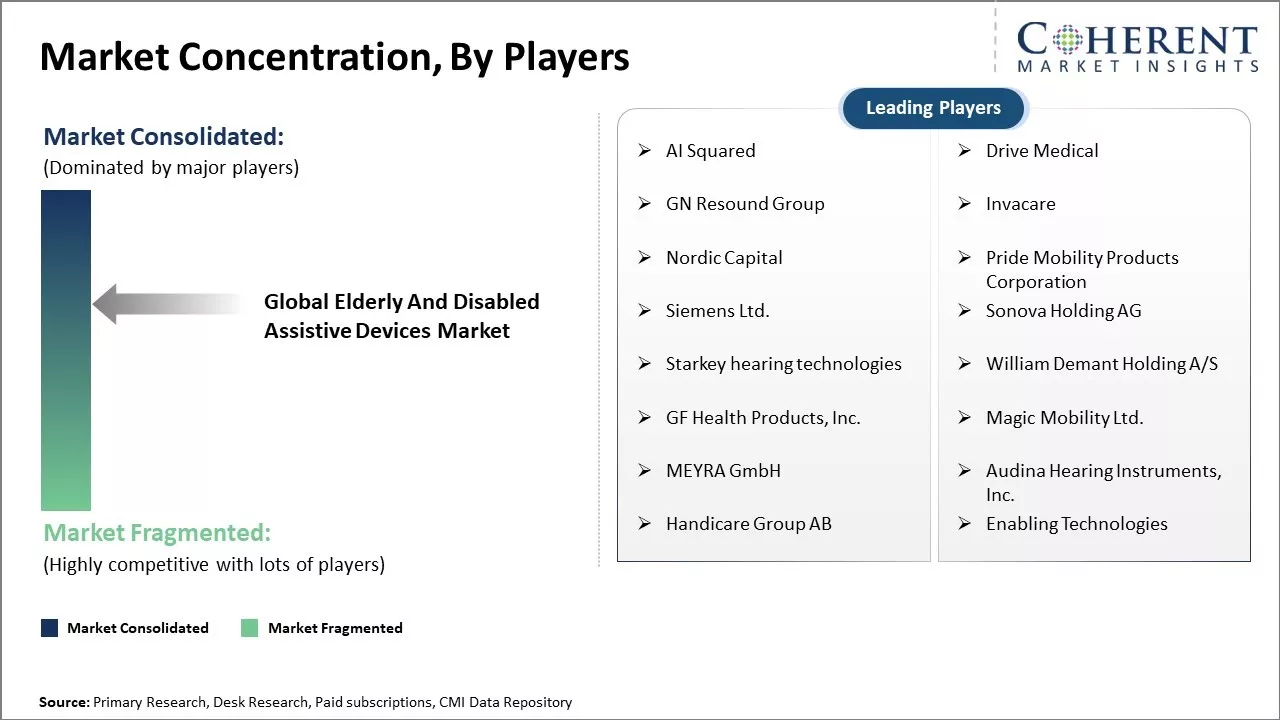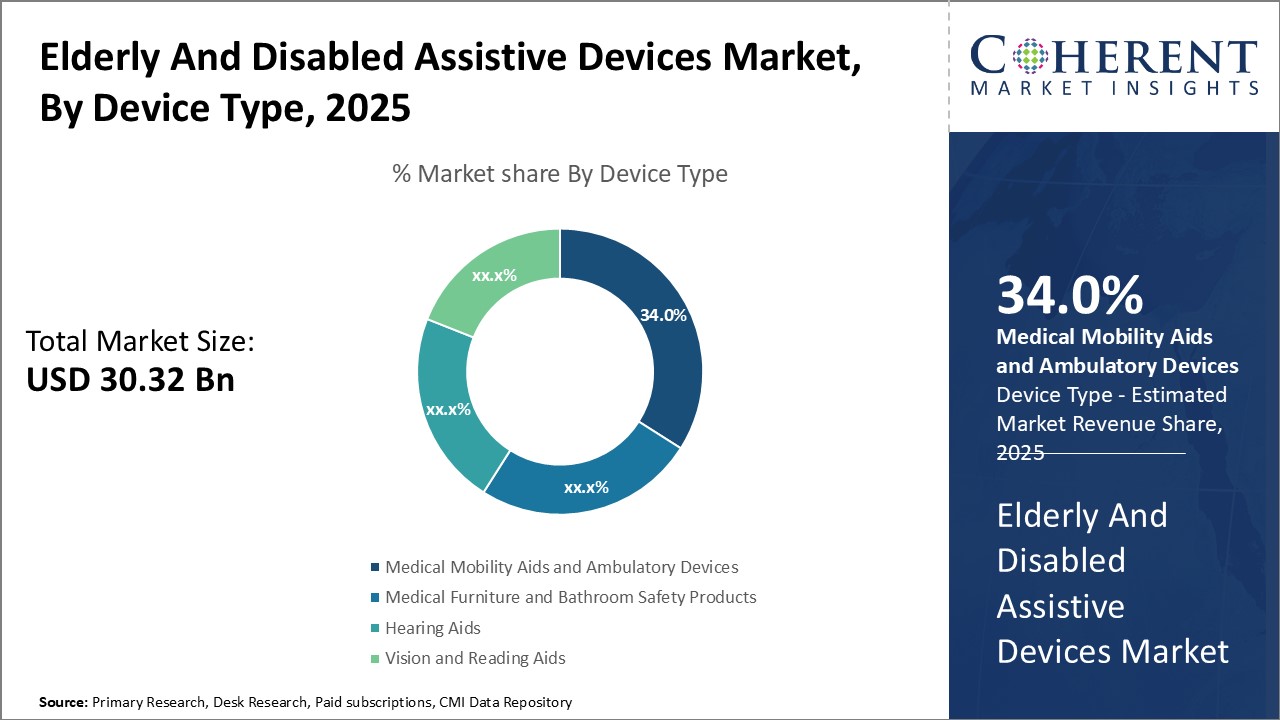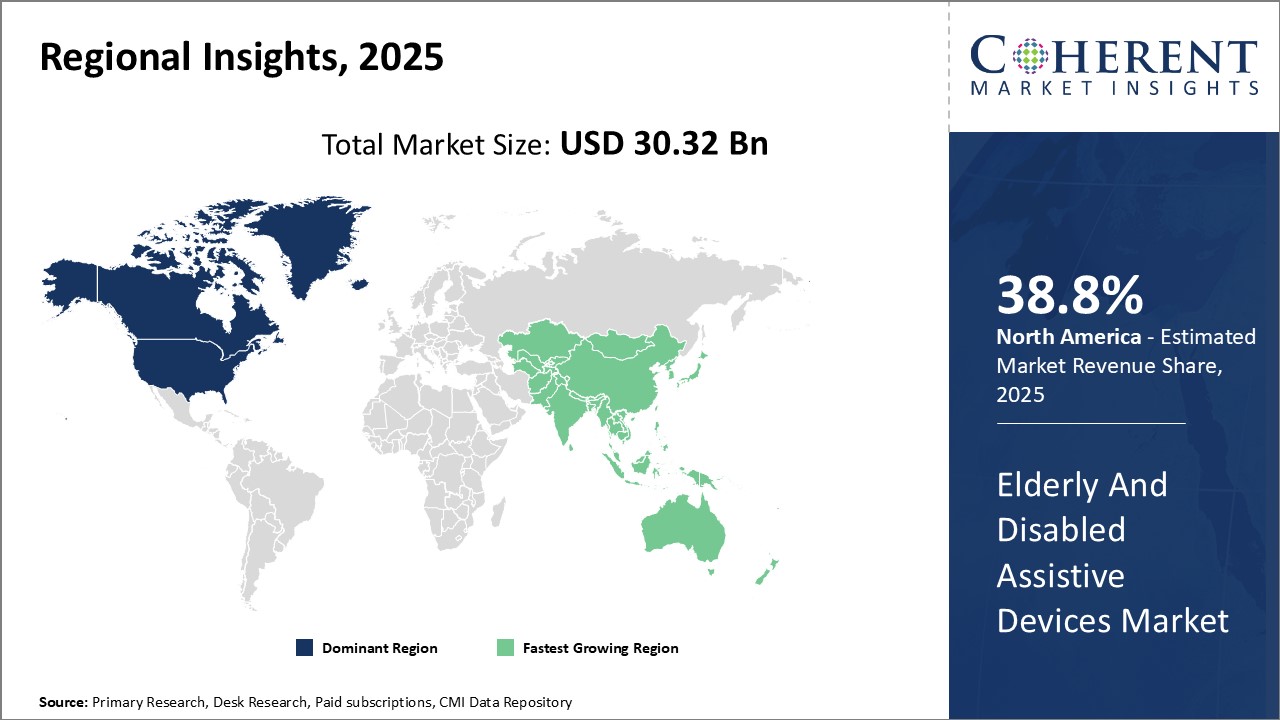Global elderly and disabled assistive devices market is estimated to be valued at USD 30.32 Bn in 2025 and is expected to reach USD 51.67 Bn by 2032, exhibiting a compound annual growth rate (CAGR) of 7.9% from 2025 to 2032.

Discover market dynamics shaping the industry: Download Free Sample
Increasing aging population worldwide and high unmet needs of elderly and disabled population can boost demand for various assistive devices such as mobility equipment, medical furniture and bathroom safety equipment. Furthermore, rising incidence of road accidents and injuries resulting in permanent disabilities along with growing health awareness can boost adoption of these assistive devices. Technological advancements in assistive devices focused on user comfort and ease of use can also drive the market growth.
Rising Government Initiatives and Funding
Rising government initiatives and funding can drive the global elderly and disabled assistive devices market growth. Many governments around the world are focusing more resources on healthcare and assistive technologies for the aging population and people with disabilities. These are implementing various national policies, action plans and programs aimed at promoting the independence, inclusion and quality of life of their citizens who require assistive technologies. For instance, according to an report published by International Labour Organisation (ILO) in 2021, the European Union has made disability inclusion and accessibility a priority area under the 2020-2027 European Disability Strategy. The strategy commits to increasing the availability of affordable assistive technologies for consumers. It will allocate over €1.5 billion in funding towards related initiatives until 2027. Japan's national disability policy for 2020-2025 focuses on promoting R&D and adoption of innovative assistive devices. The Japanese government plans to invest over US$ 650 million in subsidies and public procurement of mobility aids, prosthetics and other devices during this period. This increase in government funding and support through policies drives more innovation and accessibility of assistive devices. Manufacturers now have greater incentives to develop novel and customized solutions targeting the specific mobility, communication and daily living needs of the elderly and disabled communities in different countries and regions. Rising awareness about such technology’s boosts demand. As per UN Population Division Data, the global population aged 65 years or over is projected to double from 727 million in 2020 to over 1.5 billion in 2050. This growing demographic will require expanded access to devices that can help them live independently for longer time.

Get actionable strategies to beat competition: Download Free Sample
Rising Elderly Population
Elderly population, aged 65 years and above, is growing at an unprecedented rate. According to the data published by United Nations, the number of people aged 65 years or over is projected to increase from approximately 524 million in 2010 to nearly 1.5 billion in 2050 due to ongoing improvements in life expectancy and declining fertility levels. As people get older, these become more prone to age-related health issues as well as disabilities. Many people start facing difficulties in performing everyday activities such as walking, climbing stairs, bathing, dressing, eating and toileting. To help elderly individuals live independently and maintain a good quality of life, there has been huge demand for assistive devices and technologies suited for older users. Devices such as walkers, wheelchairs, prosthetics, hearing aids, medication dispensers are facilitating independent living. Home monitoring systems allowing remote patient monitoring are also gaining popularity. With ageing populations in both developed and developing nations continuing to expand dramatically, requirements for elderly assistive solutions show no signs of slowing down in the coming decades.
Key Takeaways from Analyst
Global elderly and disabled assistive devices market growth is driven by growing aging population as these people require mobility aids, hearing aids and other medical assistance devices. Growing demographic of elderly people of more than 65 years can boost the need for assistive technology to support independent living. Moreover, rising prevalence of chronic diseases and disabilities also boosts adoption of assistive care products.
North America dominates the market due to improved healthcare infrastructure and greater medical reimbursements for assistive products in the region. However, Asia Pacific is projected to witness the fastest growth due to increasing healthcare expenditure and large base of aging population in countries like China and India. Growing awareness about self-care among senior citizens and differently-abled groups can also offer market growth opportunities.
High costs of technologically advanced products can hamper the market growth. Lack of reimbursements in developing nations can pose another challenge for vendors. Insufficient R&D funding and technical expertise can hamper the development of innovative assistive devices. Growing collaborations between innovators, manufacturers and social organizations can enhance the affordability and availability of these devices.
Market Challenge: High Cost of Assistive Devices
The high cost of assistive devices can hamper the global elderly and disabled assistive devices market growth. The advanced assistive devices that help senior citizens and people with disabilities to live independently are often very expensive. This makes such devices unaffordable for a large section of the elderly and disabled population who have limited or fixed income. For instance, according to the data from WHO, around 70% of the elderly population in developing nations rely solely on pensions and social security benefits for their monetary needs. However, the average pension or social security amounts are barely sufficient to cover basic amenities and medical needs. Therefore, affording expensive assistive devices like smart wheelchairs, advanced prosthetics, hearing aid, and other which are priced anywhere between US$ 5000 to US$ 30000 is simply not feasible for most of the elderly people in these nations. This hampers adoption of assistive devices market in developing countries.
Market Opportunities: Increasing Mobility Limitations among Elderly Population
Increasing mobility limitations among elderly population can offer significant opportunity for global elderly and disabled assistive devices market growth. As per the data from World Health Organization (WHO), the global population aged 65 years and above is projected to increase from 703 million in 2019 to 1.5 billion in 2050. As mobility and autonomy decreases with age, there will be high need for assistive devices. Mobility limitations impose severe restrictions in daily activities of elderly like walking, climbing stairs, sitting and standing. With advanced age, disabilities like arthritis, osteoporosis and loss of muscles become more common. As per UN Department of Economic and Social Affairs report, age related mobility difficulties impact over 110 million elderly worldwide currently. Moreover, increased life expectancy has also led to rise in lifestyle diseases aggravating mobility problems.
For example, diabetes and obesity raise chances of loss of sensation in feet increasing fall risks. Thus, mobility assistive devices like walkers, wheelchairs, smart canes and crutches that aid independent movement witness huge demand. Moreover, innovative devices integrating latest technologies can also gain popularity. For instance, powered devices offer enhanced convenience over conventional products. Those with in-built sensors and location tracking provide safety to aged people living or moving alone. Growing awareness about maintaining active lifestyle among elderly and supportive government policies further encourage adoption.

Discover high revenue pocket segments and roadmap to it: Download Free Sample
By Device Type: Growing Mobility Issues Boosts Demand for Medical Mobility Aids
By device type, medical mobility aids and ambulatory devices segment is estimated to contribute the highest market share of 34.0% in 2025, due to rising prevalence of mobility issues among the elderly population. Advancing age is often accompanied by deteriorating muscles, joints and bones. Conditions like arthritis severely impact mobility and make routine tasks difficult without assistance. Contemporary lifestyles also mean fewer elders are as physically active as their predecessors. This increased the risk of age-related mobility impairments. Medical mobility aids help address this challenge by providing support and independence. Walkers, rollators and canes are top selling products as these assist with balance and relieving pressure on joints. Wheelchairs witness huge demand from people with limited ambulation. Scooters cater to individuals who can transfer but require assistance for distances. Accessories like walking belts and orthotic insoles further aid stability. These allow senior citizens to be more socially and physically engaged despite mobility constraints. Assistive devices also help prevent injuries from falls, a major health concern for the aged people. Every year, falls lead to hundreds of thousands of hospitalizations and billions in medical expenses. Mobility aids provide stability and safety monitoring. Some devices are equipped with sensors, alerting caregivers in emergency situations. Their role in reducing fall-related costs makes a strong case for public funding and insurance coverage of such products. Innovations enhancing convenience, customization and safety will boost demand.
By End User: Convenience and Cost-Effectiveness Drive Home Healthcare Segment
By end user, home care settings segment is estimated to contribute the highest market share of 35.5% in 2025, due to convenience and cost-effectiveness associated with home healthcare for seniors and individuals with disabilities. Receiving medical assistance and rehabilitation at home offers several advantages over facilities. It allows seniors to receive care in a familiar environment surrounded by family support systems. This minimizes disruptions to their daily lives. It also promotes well-being by reduced stress and healthier social connections at home. Financially, home care is more affordable for patients, families and public funds compared to institutionalization. Nursing homes and hospitals levy high room charges on top of treatment costs. Shifting convalescence and recovery to homes significantly slashes these overhead room and board expenses. Technological advances have further enabled complex medical services to be provided at residential premises competently by trained caregivers. Telehealth capabilities allow remote monitoring by clinicians. Mobility aids, safety alarms and other assistive products also empower independent living with required support.

Need a Different Region or Segment? Download Free Sample
North America dominates the elderly and disabled assistive devices market with an estimated market share of 38.8% in 2025. The U.S., in particular, accounts for the bulk of demand due to country's large aging population as well as progressive policies promoting independent living for elderly and disabled individuals. Most major global players have established their headquarters and manufacturing facilities in the U.S. and Canada to effectively cater to the demands of this region. High spending power of consumers in North America allows for the affordability and widespread adoption of sophisticated assistive devices.
Asia Pacific emerges as the fastest growing market. China and Japan, with their rapidly growing senior citizen demographics, are driving the market growth. However, other emerging Asian countries with improving economic conditions and an expanding middle-class also contribute significantly to rising usage of assistive solutions. The presence of established medical device manufacturers in nations like Japan provides affordable options to consumers. Meanwhile, low-cost manufacturing hubs like China are exporting a variety of inexpensive assistive products to other global markets as well.
Elderly And Disabled Assistive Devices Market Report Coverage
| Report Coverage | Details | ||
|---|---|---|---|
| Base Year: | 2024 | Market Size in 2025: | USD 30.32 Bn |
| Historical Data for: | 2020 To 2024 | Forecast Period: | 2025 To 2032 |
| Forecast Period 2025 to 2032 CAGR: | 7.9% | 2032 Value Projection: | USD 51.67 Bn |
| Geographies covered: |
|
||
| Segments covered: |
|
||
| Companies covered: |
AI Squared, Drive Medical, GN Resound Group, Invacare, Nordic Capital, Pride Mobility Products Corporation, Siemens Ltd., Sonova Holding AG, Starkey hearing technologies, William Demant Holding A/S, GF Health Products, Inc., Magic Mobility Ltd., MEYRA GmbH, Audina Hearing Instruments, Inc., Handicare Group AB, Enabling Technologies |
||
| Growth Drivers: |
|
||
| Restraints & Challenges: |
|
||
Uncover macros and micros vetted on 75+ parameters: Get instant access to report
*Definition: The Global Elderly and Disabled Assistive Devices Market consists of medical devices and equipment used by persons with disabilities and elderly population to improve their functional abilities and quality of life. This includes mobility aids like walkers, wheelchairs and scooters, medical furniture, bathroom safety equipment, hearing aids and assistive listening devices, vision and reading aids and other devices that enhance accessibility and independent living. The growing elderly population worldwide is driving the demand for such assistive technologies to help them overcome disabilities and live independently.
Share
Share
About Author
Manisha Vibhute is a consultant with over 5 years of experience in market research and consulting. With a strong understanding of market dynamics, Manisha assists clients in developing effective market access strategies. She helps medical device companies navigate pricing, reimbursement, and regulatory pathways to ensure successful product launches.
Missing comfort of reading report in your local language? Find your preferred language :
Transform your Strategy with Exclusive Trending Reports :
Frequently Asked Questions
Joining thousands of companies around the world committed to making the Excellent Business Solutions.
View All Our Clients